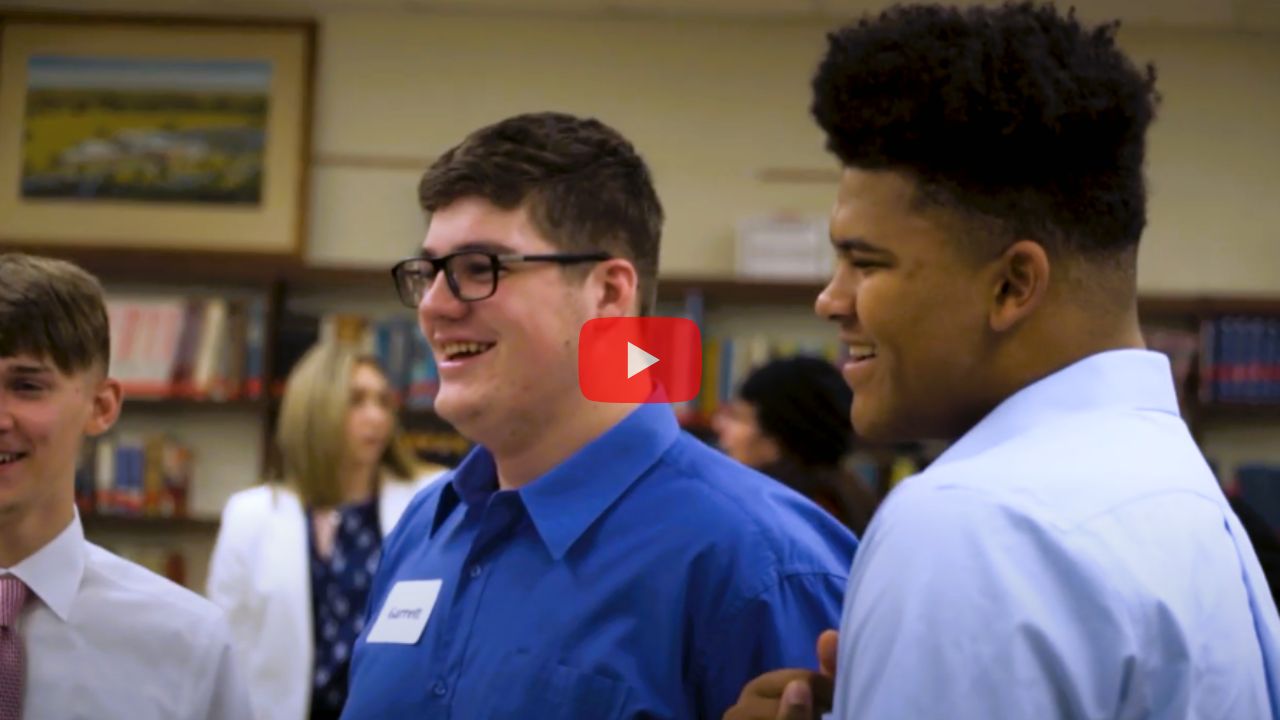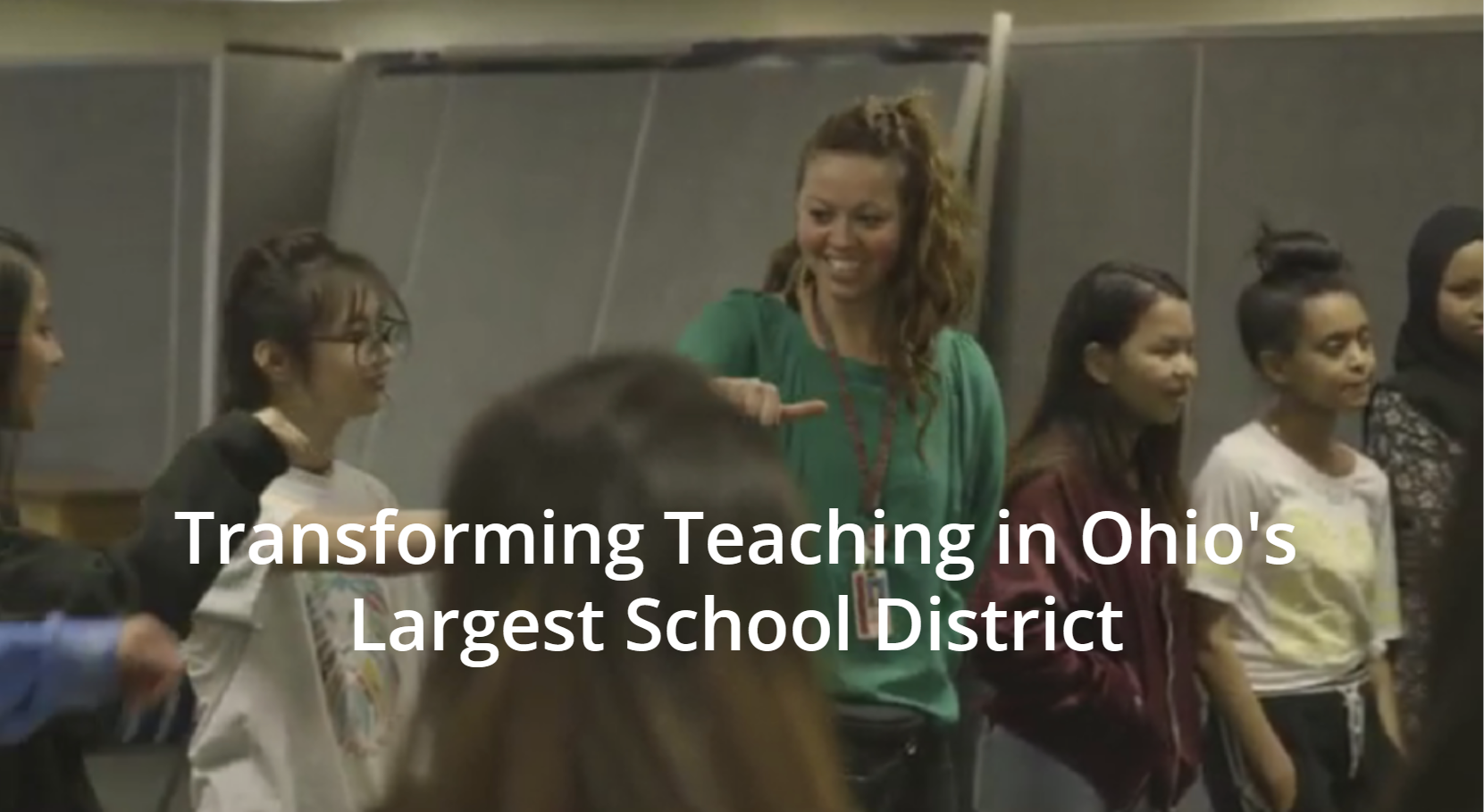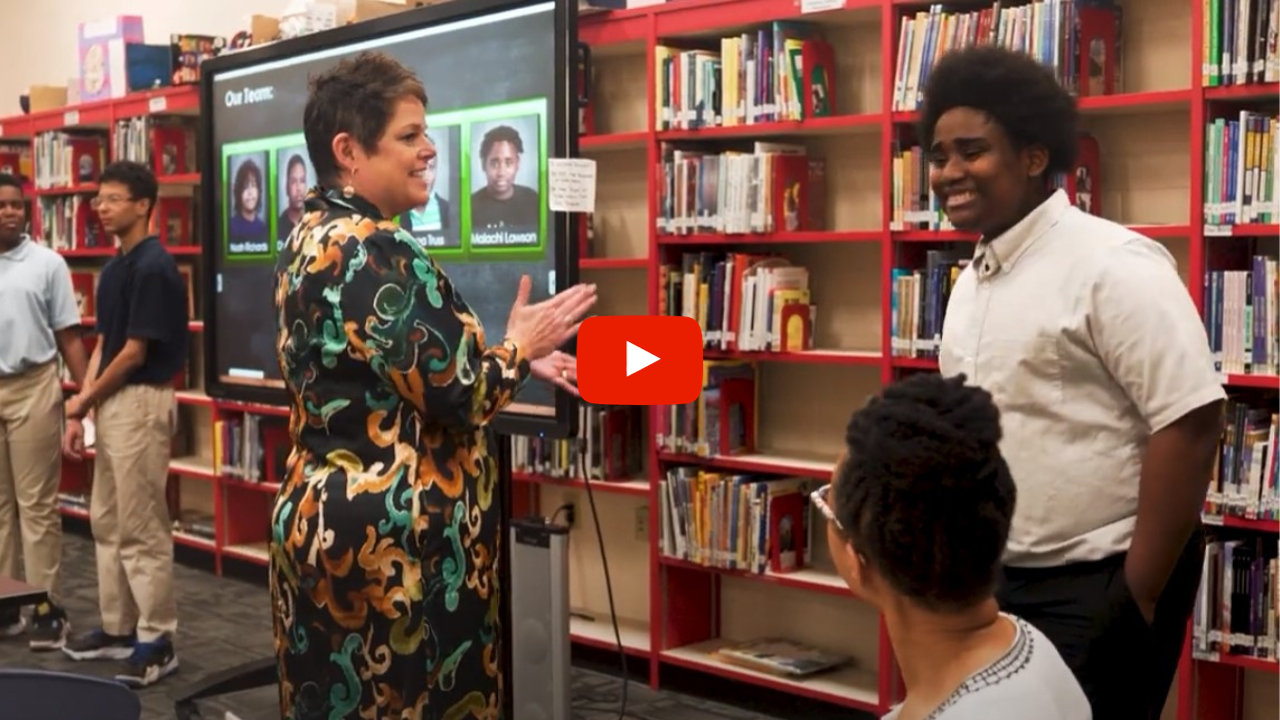In this episode, Doris speaks with Jay Scheurle, Head of School and Entrepreneurship teacher at Miami Valley School. Jay describes how he modeled a radical new method of teaching and learning for his school by implementing a high school entrepreneurship course.
Do School Better: A Podcast for People Who Want to Transform Education - Listen to more episodes here
Doris: Hey, Jay.
Jay: Hi, Doris.
Doris: How are you today? Wait, what is today?
Jay: Today is commencement tonight. So, other than this podcast, I have a busy evening.
Doris: Oh, my gosh. Okay, wow. Well thank you for having a conversation on graduation day. Wow.
Jay: Yeah, thank you for inviting me.
Doris: Yeah, no, I’d love to. And Jay, if you could tell the listeners a little bit of who you are and what you’re doing, that would be fantastic.
Jay: Sure. I’m the Head of School at the Miami Valley School in Dayton, Ohio. And we’re an independent early childhood through 12th grade school with about 500 students. And we’re looking at lots of ways to innovate and are teaching practice. And teaching this class on entrepreneurship has been a great opportunity for me to have to practice the ideas that we’ve been talking about.
Doris: Yeah I have to say that you, as a head of school, coming to the workshop and saying, “I wanna build a program and teach it at my school. This is the best way I can practice myself what I’m trying to get my teachers to do.” I was really impressed with that. That’s a very rare thing.
Jay: Well yeah, I’ve enjoyed it. And I don’t know how, as a head of school, I can talk about ideas with teachers without saying that “Look, I’m going to get into the trenches with you and try this, and admit how difficult and hard it is, as well as celebrating the victories.” So, I think it’s important for heads of school to not just talk about innovation, but have to do it as well.
Doris: Yeah, I agree with that. That’s what we’re doing. We’re practicing something completely new. So, when you came to the workshop, you had decided to create an entrepreneurship program, and you implemented after this past year. You implemented your pilot year of the entrepreneurship class. Can you talk a little bit about what you implemented, and what this class was, and what you did?
Jay: Right. Well, first of all, I came to the workshop thinking that I was just going to learn about entrepreneurship, and then I would have to go back and integrate that content into creating an innovative program. And I discovered in the summer workshop was something so different and so wonderful. Doris, you made my life so much easier because you’d already done a lot of the innovation. And one of the ideas you shared from the beginning is that students need to be de-schooled, and the traditional education is broken. And this workshop helped me to see how a different concept of teaching and learning, put into the context of entrepreneurship could be so powerful.
So, I think that’s actually one of the most important premises of what I learned over the summer is that we’re trying to rebuild education. We’re trying to re-conceive teaching and learning in a way that’s student-centric and puts the emphasis on what the students are learning, and creating opportunities for students to take ownership of their own learning, and to connect it to their own passions and to connect it to the real world around them. And that in an entrepreneurship, that the deep content knowledge that we’re providing which really is at a college equivalent level, ask them to demonstrate this, not through tests and quizzes, but through application in solving real business problems. And that was transformative for me to see that I wasn’t just going to learn about entrepreneurship, but the whole approach to this was absolutely what I was hoping to create myself. And you created a lot of the framework for me and made it so much easier.
Doris: Oh, I’m so glad. And you know, it’s funny. Literally every time I do one of these, during the first break on the first day, I have one, two, or five people come up to me and say, “Oh, wow. I thought I was coming to an entrepreneurship workshop. This is about a new way of doing education, of doing school.” And that’s right. I mean, we’re all talking with all these big words. Innovation, entrepreneurship, guide on the side, and teaching students skills in addition to deep learning of stuff, we have to figure out how to do that well. How do you actually implement that well in school, in academic courses? And it’s an entirely different thing, yeah.
Jay: Right, and that’s not to minimize the entrepreneurship side of this because I do believe that the skillset of an entrepreneur, the willingness to take risks, and to try things and to fail, and to iterate and pivot, those…the design thinking that’s behind all of this, those skills as an entrepreneur are incredibly valuable to students. But I think you’re right, that this class goes well beyond that because we’re really putting in place a model that could be equally transformative, whether you’re teaching calculus, or biology, or statistics. There’s ways of taking the opinions about teaching and learning and applying it in their discipline. We just have this wonderful opportunity to do it in the field of entrepreneurship which is an exciting field in itself.

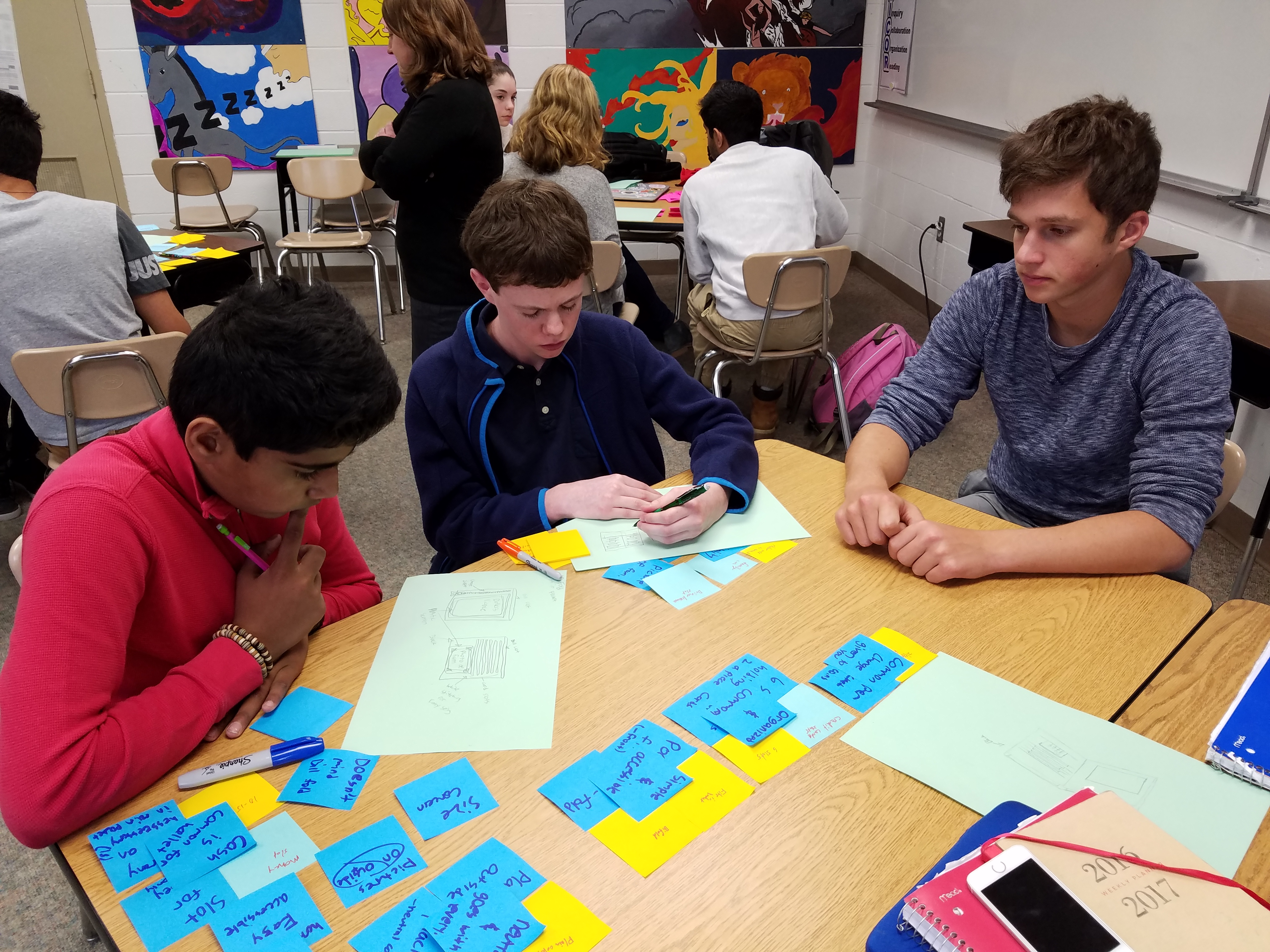
Doris: Yeah, it is an exciting field. And I agree with you in what transcends all these classes that teachers I work with and schools I work with are doing, whether it’s a science class or an entrepreneurship, are those entrepreneurial skills. Those that you mentioned, that’s really the most important element of all this, I think. That entrepreneurship, it’s not the subject matter itself. While the subject matter itself is really worthwhile, and very rich, and very important as an academic subject, I believe that and I’m excited to see all over the world that entrepreneurship is being added to high school and even some middle school requirements by governments even. I just talked to somebody in Singapore before this call, and they talked about the Ministry of Education coming out with an edict that they’re now adding open-ended entrepreneurship questions to their standardized test, which is kind of funny. But if you think about it, it’s like a mix of things that is kind of funny. But anyway, these skills you mentioned, those entrepreneurial skills, that’s really the powerful part. And that’s, whether it’s a science class, history class, or an entrepreneurship class, having students develop and master those skills, we’ve got to do that. We’ve got to do that in schools.
Jay: Right, I agree. On the entrepreneurial side, I found it extremely helpful that you had already made this connection with Steve Blanks’ work and the Lean LaunchPad, and I had not been aware of that. So, that was just a wonderful world to be opened up to me. And also, as I talked to businesses in my community and told them what I was doing and talked about the lean startup methodology and working with Steve Blanks’ videos, that was an immediate connection because many entrepreneurs and business people know about this sort of shift in practice. And so, I felt like that was an incredibly valuable resource for me to have access to. We also used the Lean LaunchPad system as well this year which made it…it was easy. It’s an easy way. It’s a little more expensive, but it’s an easy way to deliver the video lessons and to have the students do the custom development work and be able to track those interviews and see how it affects their iteration of value proposition, customer segments, and other parts of the canvas. So, those tools are incredibly deep. And I also found it very helpful to have all of the access to some of the TEDx talks that your class has worked with, the book lists that you’ve worked with. So, the students in my class came to this class with incredibly rich, deep, practical, relevant, cutting edge content that was useful.
And what I also, and this then goes sort of beyond the entrepreneurship approach, is you were able to design this in a way that was a flipped classroom. So, all this content delivery, all the content, it’s not teacher-driven, standing in front of the room lecturing the class and providing all the content. All these contents available to students outside of class, and so they watch all these videos and they do the TEDx reviews, and they read the books outside of class, and we spend the entire class period. We we’re fortunate to have an 85-minute block, classroom block of time, where the students just worked in teams and they’re problem-solving, and they’re working together and they’re trying to figure out how to ask the right questions when they talk to customers, and they’re starting to do prototyping of the product. And the class itself is a fun, dynamic, noisy, active, constructing type of place. And to me that’s what I think classrooms should look like. And this flipped classroom is I think a wonderful model to try to practice here an entrepreneurship, but I think it has other applications.
Doris: Well, yeah it’s powerful. So, Lean LaunchPad which I refer to as really, contemporary scientific method, right? All these stuff, we have students as I’m sure you do, who teach themselves to code, who go deep into human-centered design. That content exists in all kinds of different forms, that students find themselves and ingest themselves, and it’s using that class time for students to learn by doing, is really powerful. And whether you have 85 minutes, 3 hours, or 45 minutes, preserving that time for them to do that is great. Can you touch… You’re talking about something really powerful. Please talk about what did you experience and learn about the practice of teaching during this pilot this year.
Jay: Well, the model of teaching that we’re talking about here, this is different than what I used to do in the past where I really was the person standing in the front of the room delivering content and then hoping the students were listening and understanding that. And this approach is, we say it’s student-centric, but to get beyond just sort of the words of that, this has been an opportunity for me to really observe students, sit-in conversations that they’re having where they’re trying to solve problems, and to help ask them the right questions, and help to try to steer them in the right direction. I’ve been able to get to know students on a very personal level because I’ve been right in that mix of them working through these issues, as well as working through the issues of what it’s like to work on a team. So, there’s a dimension to this that’s just amazing as a teacher that you really feel that the reason you’re there, it’s really about the student growth and that’s the only thing you’re focusing on. You’re not thinking about, “Am I delivering my content right? Am I getting all of this right? Am I…” You’re 100% focused on the students and their understanding and their growth, and helping them try to figure this out on their own. And that is a…that’s actually for me been the most fulfilling part of this whole experience, is that it’s enabled me to be so connected to the students in a way that I don’t think, as a traditional teacher, I was.
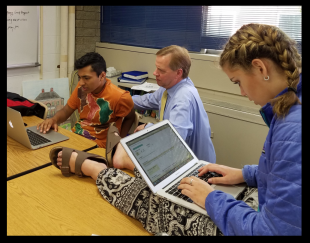
Doris: And do you…when you think about the impact on the students… Okay, this was an academic course that these students took. As a teacher, as a head of school, as an educator, how would you describe the impact on students, the learning impact on students?
Jay: Yeah, it’s amazing. I think, again, the way this class is structured where there’s a lot of videotaping, creating YouTubes of their own experience, a lot of personal reflection, the transformation that they can see in themselves from the very first day when they have to stand in front of the class and, using the Business Model Canvas, start with having to explain a business that they admire and how it fits into this model canvas, and they were so nervous getting up in front of their classmates and they were fidgeting, and they were pacing, and they really didn’t know a whole lot about business or entrepreneurship. And then to see that evolve over time, every time they had to be in front of the camera, every time they had to make a presentation, they got better and better. They picked up all these skills of research and interviewing customers and finding facts to back-up all of their hypotheses and their conclusions and their solutions to the problems.
And I think now for the students to look back as they’re working on their capstone, just their opportunity to reflect on all of their learning, they can’t even believe…and the parents have told me this too, because students can’t believe where they’ve come to. The poise, the confidence, the depth of their research. Their ability to stand in front of… We had a shark tank experience and they stood in front of four incredibly impressive and scary CEOs and entrepreneurs, and they made fantastic presentations. And I heard both from the sharks, as well as from the parents, how impressed they were with the students and their thinking, their hard work, and their ability to present in such a confident way. And that didn’t…that wasn’t there on those first few days of class. That all has been developed through this class experience.
Doris: And part of what’s impressive is not only the way in which the students present but what they’re presenting, and the depth, the quality of the data, the research, the communications, the qualitative and quantitative evidence and persuasive arguments to back-up their proposals. And one of the things I’d love for you to talk about as a private school, your parents are sending their students to you in the hopes that they’ll be, you know, it’s still a college preparatory game we’re all playing, right?
Jay: Right, right.
Doris: And we…there’s this wording historically that educators use about rigorous academics. Talk about how that term, rigorous academics, hits you in the context of this course that you taught this year.
Jay: Right. I think that’s a great question and it’s something we are thinking quite a bit about at our school, as we do think that delivering a rigorous academic experience is a critical part of who we are, and being the best college preparatory school in the region is something that’s important to every single one of our parents. But I think that there is a shift that’s occurring in the educational world, and I think this shift is happening with teachers, and I think it’s starting to happen with parents, and we’re helping it to happen with parents, to realize that rigor is not just the ability of a student to memorize a lot of content and be able to put that back accurately on a piece of paper or on a computer. That there’s a depth of rigor that involves thinking, and analyzing, and synthesizing, and developing skills that also go with that. Because learning to really do good research, and learning to ask the right kinds of questions, and learning to be organized and work with a team, there’s deep rigor that actually, it exists to all that. So, I think that there…this class…we could not deliver this class unless we could convince parents that there’s a rigor to this.
Now, having all of the content coming from the Lean LaunchPad methodology helped, because when parents hear about what we’re doing, and know that this is college-level course work, they realize that their students are getting an understanding that fully covers the full spectrum of what it’s like to get a business started all the way from all of the value propositions, and the customer segments, and everything that produces revenue, as well as all of the aspects of building the cost side of business. And that is incredibly complex and the students are wrestling with all of those aspects in a pretty amazing way in a first-year class. I think the students see this. And I think even the CEOs who were part of this presentation were actually very amazed that the students were grappling with so much on a content side of this. In some ways, I think more than if you watch the TV show “Shark Tank,” what our students are working with is much more comprehensive than, and much deeper, and much more content-based.
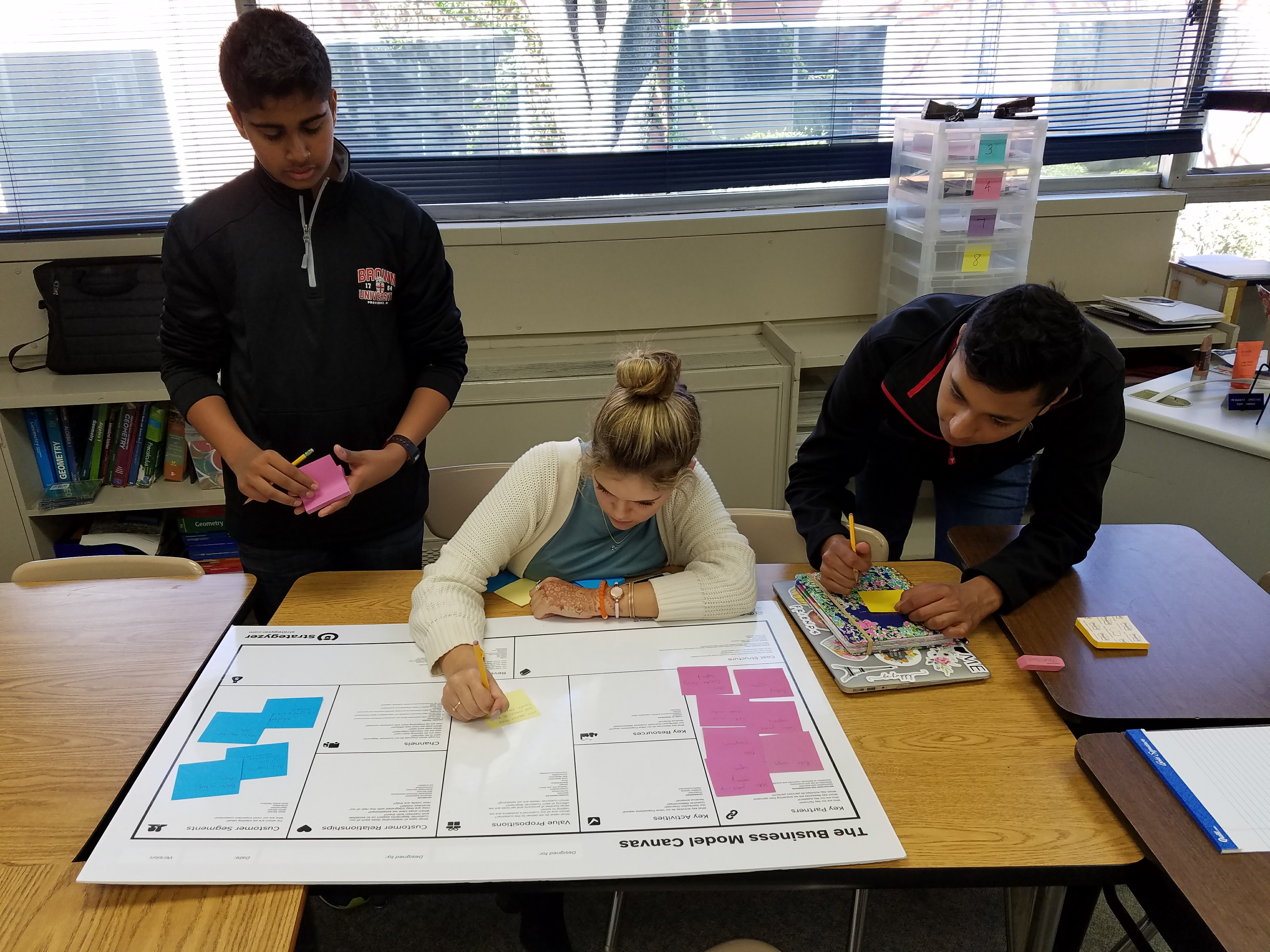
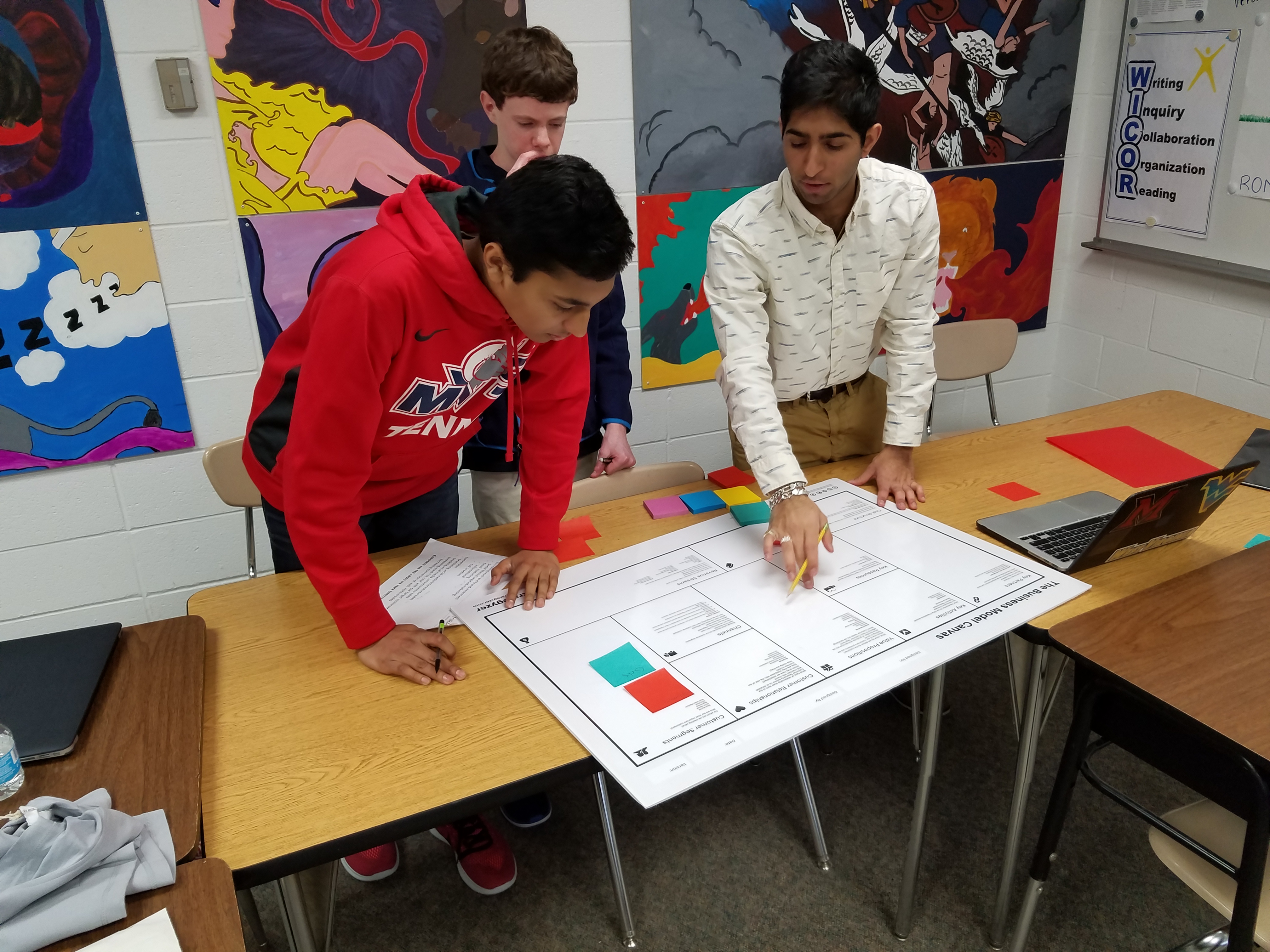
Doris: Yeah, it’s interesting. In the early years of this, I also found it helpful in my own community when I was creating this class to begin with, to be able to point to Lean LaunchPad as a, you know, Stanford, Berkeley, National Science Foundation resource. We’ve evolved…our communities have evolved past that. So, they understand and recognize that this is far more than…that the methods and the model and the learning is far beyond what you can explain by saying Lean LaunchPad. But what I like very much about what you said is that we’re trying to help everyone redefine what academic rigor means. And that developing in our students the ability to think really well, that’s kind of gruesome way to say it. But, you know, how you think and how you process, as opposed to what to think. The process more than the product. The process is what’s important. We have to, all of us, we have to redefine what rigorous academic learning means. And that’s I think the part of what’s happening here. So, Jay, what’s next? You’re the head of the school, you personally took on this challenge and dove in while continuing to lead your school, you taught the pilot. You took on this crazy, new kind of course, and did it incredibly well. And your blog is really interesting. People should read about your experience. But what’s next?
Jay: Well, in this class has provided me an opportunity as head of school because I took… I do write a blog that a lot of parents read. It’s given me an opportunity to really use this class to talk about education and teaching and learning in a much bigger way. And I love the fact that this, what I may say now is not just words, it’s rooted in what I actually see in students doing at school. So, I plan to keep doing this. Now, my class is just a one semester class, and realistically that’s all I could possibly do.
Doris: Yeah, I’m sure.
Jay: So, I won’t be teaching in the fall. And in some ways, I’m gonna probably utilize the fall a little bit more effectively to get ready again for this class in the winter and spring term. But I’m gonna keep teaching this class. And I have others that are working with me. It’s been very helpful. My assistant head of school for finance and operations is a co-teacher with me in this class. My technology and innovation director has been a part of this, especially in the prototyping side of this class. Our librarian’s been involved in some of the research sides. So, I got other people involved with me, so I’m not doing it all on my own. And that’s been actually a big help for me to not feel that I’m doing it by myself, but also just to have all those colleagues who can have input and ideas to share, and we’re working together as a team, and that’s a great feeling as a teacher. You feel like we’re teaching this as a team.
Doris: Yeah, well I also have been an administrator full-on while teaching the class and creating it, and you literally can’t do it without co-instructors. But I agree that even if you could do it alone, doing this as a team is powerful for the students and also for the teachers.
Jay: Right. I would recommend if a teacher…there’s a way you can get somebody, that even if it’s not all the others step-in to help during different parts of the class, having that input, and having others that can share perspective with you, other adults, is great. And I think you’re right, it’s great for the students too.
Doris: And finally as you think about what impact you’re hoping this has on, you know, you have an entire faculty there, your entire school community. Do you see this having any impact over the next stretch beyond this class and the specific teachers that you’re working with?
Jay: Absolutely. I remember a couple of years ago as we were rolling out new ideas for our philosophy of teaching and learning in our school, which we call the immersion method. And it’s a very innovative, student-centric approach, and that we provide students with immersive experiences. And the teachers said to me, “Well, Jay, what do you want us to do? How should we build our classes?” And my thought at the time was, “Well, I’m not gonna tell you how to design a class.” Because we have these ideas, but each teacher really has to figure out how to take these ideas and integrate it into a particular discipline, and integrate it into a particular group of students. And what this is gonna look like in each class may be very different. There may be some aspects of this that are gonna be similar, which is moving away from lecturing and more student engagement. But I think what this looks like has to also have the room for teachers to take ownership of this themselves and be motivated to wanna make this work in their own class.
And so, for me, this was an opportunity to say, “For Jay Scheurle, and for entrepreneurship, for this particular group of students, this is what we did.” And this was clearly exciting. And I’m gonna put this out in front of you, not to say you should do this, but this is an opportunity to just say, “Wow, this is what one teacher and one discipline could do with this. I wonder what I might do taking this in a way that relates to my discipline, and my kids, and my background, and my passions. And where would I go with this?” And that’s I think what we’re trying to do. And I’m hoping this class is a way to illustrate what I did, not so much as a head of school, but what I did as an instructor in this class, in a way that it engaged with the kids so that teachers had the opportunity and the freedom to innovate and come up with their own ideas to do this.
Doris: Yeah. That’s beautiful. The people think about specific curriculum, like Lean LaunchPad or whatever else. And actually, what we’re talking about is every teacher is a designer. They’re designing the learning experience for their students. Every one of them. We’re giving them some methods, some examples, some experiences for teachers to go through so that they can themselves be equipped with a toolkit that they draw from. A palette. But they’re designing the experiences themselves. And that’s, you know, in the same way that having students’ learning path be individualized and personalized as we talk about, and seeing how empowering it is for students to learn about their own strengths and develop those. The same is true with teachers. Empowering teachers to design the learning experiences that they provide for their students. I love that. Jay, I am so excited to see where you take your school with your incredible leadership, and that you are leading and also doing is, says everything about the way you run your school and the way you do your work. And I’m really honored to be able to work with you, I have to say.
Jay: Doris, thank you. And thank you so much for everything you helped provide to make this possible. I can’t even imagine having to try to create all of this. All of the research that you provided, all of the rule books that you shared, all of that was so helpful especially for a first year. And I’m sure that I’ll iterate and adjust and find ways to move forward, but having that framework that I learned at the workshop was so helpful. So, I’d encourage anybody that is interested in teaching and learning in this way, or entrepreneurship, to take the workshop because the tools you’re gonna get will be so incredibly valuable.
Doris: Well, that’s great. And thank you, Jay, and good luck with graduation tonight.
Jay: Good. Thank you very much, Doris.


